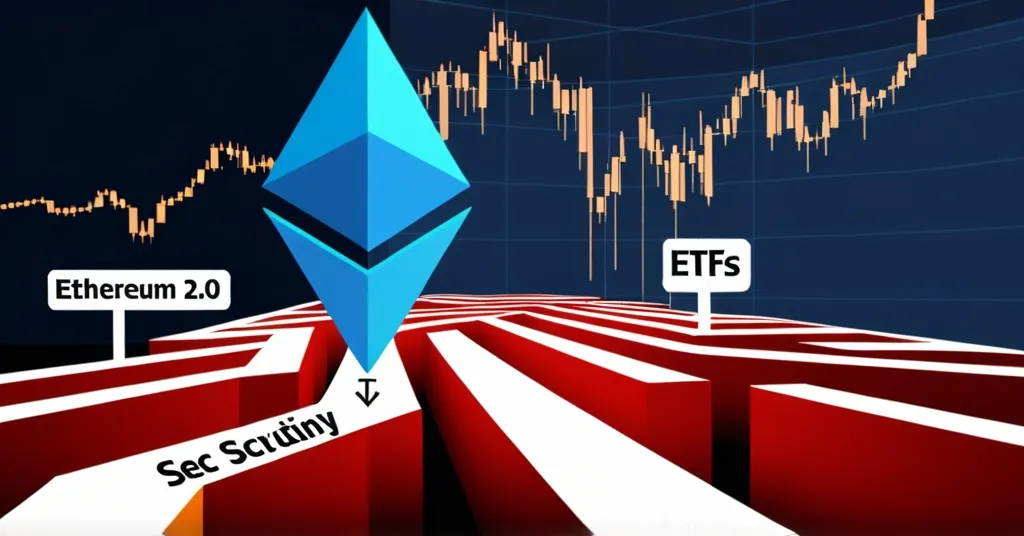Ethereum 2024: Navigating Upgrades, SEC Scrutiny, and ETFs Amid Price Stability

Ethereum’s Journey in 2024: Navigating Innovations, Regulatory Hurdles, and ETF Milestones Amidst Price Disappointment
Ethereum stands at a pivotal juncture in 2024, balancing significant technological strides with regulatory challenges and market volatility. The Ethereum 2.0 upgrade aims to boost scalability and reduce energy consumption, while the growth of decentralized finance (DeFi) and non-fungible tokens (NFTs) continues to flourish. However, regulatory scrutiny from the U.S. Securities and Exchange Commission (SEC) casts a shadow over these advancements. The approval of Ethereum Exchange Traded Funds (ETFs) marks a significant step towards mainstream adoption, yet the expected price surge has not materialized, reflecting a cautious investor sentiment.
- Ethereum 2.0 upgrade aims to improve scalability and reduce energy consumption.
- Regulatory scrutiny from the SEC impacts market dynamics.
- Approval of Ethereum ETFs marks a step towards mainstream adoption, yet price remains stable.
- DeFi and NFTs continue to grow despite challenges.
Technological Advancements: Ethereum 2.0
Ethereum 2.0, also known as Eth2 or Serenity, represents a monumental leap forward for the platform. This upgrade addresses long-standing issues of scalability and energy consumption, crucial for Ethereum’s sustainability and growth. Ethereum 2.0 introduces several key changes, including the transition from Proof-of-Work (PoW) to Proof-of-Stake (PoS) and the implementation of shard chains to increase transaction capacity. The shift to PoS, where validators are chosen to create new blocks based on the number of coins they hold and are willing to “stake” as collateral, is expected to reduce energy consumption by 99.95%.
“Ethereum 2.0 represents a pivotal moment for the blockchain, promising to enhance scalability and reduce energy consumption dramatically.” – Vitalik Buterin, Ethereum’s co-founder
The upgrade is rolled out in phases, with the Beacon Chain (Phase 0) launched in December 2020. Subsequent phases, including the implementation of Shard Chains (Phase 1), the Merging of ETH1 and ETH2 (Phase 1.5), and Execution Environments (Phase 2), aim to gradually improve the network’s capabilities. While the full implementation of Ethereum 2.0 remains ongoing, its potential impact on Ethereum’s performance cannot be overstated.
Regulatory Challenges: The SEC’s Influence
The expansion of DeFi and NFTs on the Ethereum network continues unabated, showcasing the platform’s versatility and innovation. DeFi, or decentralized finance, offers new financial instruments like lending, borrowing, and trading without intermediaries, while NFTs have revolutionized the trading of digital art and collectibles. However, these sectors are not immune to regulatory scrutiny, particularly from the SEC in the U.S.
The SEC’s increased enforcement actions against various entities in the crypto space have introduced uncertainty. The regulatory body has charged several companies and individuals for unregistered offerings of crypto assets and securities fraud, signaling a broader crackdown that could impact investor sentiment towards Ethereum and other cryptocurrencies. This regulatory pressure highlights the delicate balance Ethereum must navigate between fostering innovation and complying with regulatory frameworks.
Market Impact: Ethereum ETFs and Price Dynamics
The approval of Ethereum-based ETFs in the U.S. marks a significant milestone, signaling a step towards mainstream adoption. ETFs allow investors to gain exposure to Ethereum without directly owning the cryptocurrency, potentially attracting a broader investor base. However, despite this development, Ethereum’s price has not soared as anticipated. Market analysts attribute this to a cautious approach from investors, influenced by broader market conditions and regulatory uncertainty.
“Despite the ETF approvals, Ethereum’s price has not soared as anticipated, suggesting a cautious approach from the market.” – Market Analyst
This price disappointment underscores the complex interplay of technological optimism and regulatory caution that Ethereum navigates in 2024. It also highlights the importance of broader market factors and investor sentiment in determining cryptocurrency prices.
Innovation and Competition: DeFi, NFTs, and Beyond
Ethereum’s journey in 2024 reflects broader trends in the cryptocurrency sector, where innovation often meets regulatory forces head-on. The Ethereum 2.0 upgrade demonstrates the platform’s commitment to addressing core challenges, while the SEC’s scrutiny mirrors a global trend towards regulating digital assets. The cautious market response to Ethereum ETFs suggests that broader market factors and investor sentiment play a crucial role in the cryptocurrency’s trajectory.
Despite these challenges, Ethereum remains a critical player in the blockchain ecosystem, championing decentralization and disrupting traditional finance. However, it must keep an eye on competitors like Cardano and Polkadot, who are also vying for dominance in the Proof-of-Stake arena. These competitors, already operating on PoS, pose a threat to Ethereum’s market position, underscoring the urgency of its upgrade.
Ethereum’s Future: Staking and Beyond
As Ethereum continues to evolve, one of its most promising features is staking. Staking allows users to earn passive income by holding Ether, potentially attracting more users and increasing demand for the cryptocurrency. This feature, part of the Ethereum 2.0 upgrade, could significantly impact Ethereum’s market dynamics.
Despite the challenges, the successful implementation of Ethereum 2.0 remains essential for the platform’s long-term sustainability and market position. Technical difficulties or delays could impact Ethereum’s price and user confidence, highlighting the importance of a smooth transition.
Key Questions and Takeaways
What is Ethereum 2.0 and how does it aim to improve the Ethereum network?
Ethereum 2.0 is an upgrade focused on enhancing scalability and reducing energy consumption through the transition to proof-of-stake and the implementation of shard chains.
How have regulatory actions by the SEC affected Ethereum?
The SEC’s regulatory actions have increased market uncertainty and potentially dampened investor enthusiasm due to fears of regulatory repercussions.
What impact have Ethereum ETF approvals had on the cryptocurrency’s price?
Despite the approvals, Ethereum’s price has not surged as expected, indicating a cautious market response influenced by broader market conditions.
What are the key areas of innovation for Ethereum in 2024?
Key areas include the Ethereum 2.0 upgrade, the growth of decentralized finance (DeFi), and the continued expansion of non-fungible tokens (NFTs).
How does Ethereum’s staking feature contribute to its future growth?
Staking allows users to earn passive income by holding Ether, potentially attracting more users and increasing demand for the cryptocurrency.
What challenges does Ethereum face from competitors like Cardano and Polkadot?
Ethereum must maintain its technological edge and navigate regulatory challenges while competitors like Cardano and Polkadot also develop in the Proof-of-Stake space.
Ethereum’s journey in 2024 is a testament to the resilience and adaptability of blockchain technology. As it continues to push the boundaries of what’s possible with decentralized systems, Ethereum remains a beacon of innovation, even as it navigates the choppy waters of regulatory scrutiny and market volatility.



